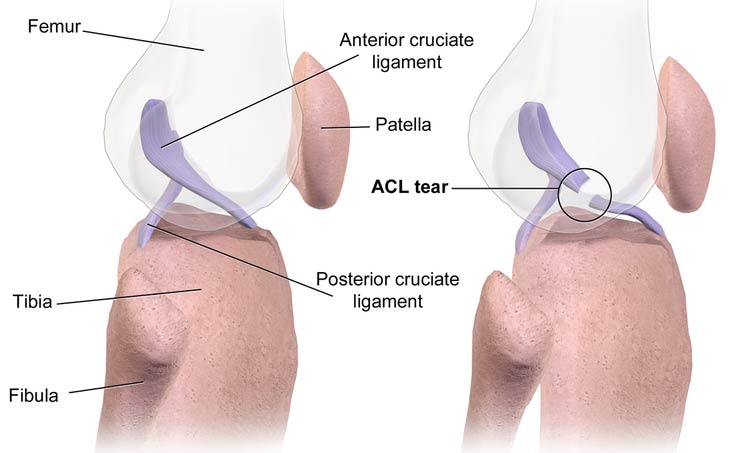5 Most Common Injuries in Soccer and How to Treat Them?
Soccer is the most popular sport in the world, and is played by more than 250 million people worldwide. It can be an intense physical activity, with the potential for contact-related injuries, slips, falls, and overuse injuries. Soccer injuries can occur acutely, with an impact, or twist or something that happens in the run of play. They can also be caused by cumulative effect, by using the same tissues repeatedly over a season. Here are the five most common soccer injuries, and how to treat them.

1. Hamstring Injuries
Hamstrings can be injured either by overuse, undertraining or with an acute trauma or accident. Often, hamstrings are imbalanced between eccentric and concentric strength, which leads to hamstring ‘pulls’ when a player tries to slow down too fast. This can be corrected with a physiotherapist, who will prescribe exercises to help correct this imbalance, and also provide soft tissue treatment, deep tissue laser, or other modalities to help heal the acute injury. Hamstring strains can also be caused by accidental contact, a slip on wet grass, or other unlucky reasons. Through a soccer season, as muscles become fatigued, injuries become more likely. It is important for players to warm up properly before games, and to stretch post game.

Hamstrings can also be injured from a direct blow. This could be contact with another player or the ground. This is less common and is often resolved by managing the pain and swelling.
2. Ankle Sprains
With the amount of running, starting and stopping, and kicking involved with soccer, ankle sprains are very common. The most common of these sprains are anterior talofibular ligament sprains. These are most likely to occur when a player rolls over the outside of their foot. The foot and lateral ankle will often swell, and make it hard to bear weight.

Photo Credits: Scott Ableman
Ankle sprains are Graded as a 1,2, or 3, which measures the severity of the injury. All three grades of ankle sprains can be treated with physiotherapy or chiropractic care. Often, deep tissue laser, light muscle work, mobility exercises, and taping are the evidence-informed course of treatment. Imaging is sometimes required as well, as with severe ankle sprains, at times the ligament can cause an avulsion fracture as well. Whatever the severity, rehabilitation exercises are required to help prevent future injury to the same ligaments.
3. Concussions
Head trauma is a concern in any fast-moving sport, and that is no different with soccer. Players are at risk of concussions from direct contact with the ground, other players, or even the ball in rare instances. A Concussion can be a very serious issue, as any injury to the brain can lead to long-term complications. Concussion symptoms include sensitivity to light, headaches, dizziness, neck pain, and other issues that significantly affect a patient’s quality of life and their ability to perform the tasks of daily living. Concussion treatment involves a strict return to play formula that takes at minimum five days to complete but often requires much longer. A physiotherapist who is trained in concussion management is a good option to help improve symptoms and speed up recovery from concussions.

Before a player returns to soccer, they must go through the following timeline:
- Be symptom-free for 24 hours after no activity
- Be symptom-free for 24 hours after light activity
- Be symptom-free for 24 hours after sport specific activity
- Be symptom-free for 24 hours after full-contact practice of their sport
If you are concerned that you might have suffered a concussion, seek care immediately to avoid long-term complications from untreated head trauma. Concussions can prevent people from doing their job, driving, socializing, or other parts of life outside of sports.
4. ACL (Anterior Cruciate Ligament) Tears
Knee injuries are also common in soccer, and are due to the fast starting and stopping nature of the sport. Contact injuries can also cause knee ligament or meniscus damage, but the most common form of injury to the knee is specifically anterior cruciate ligament injuries and tears. The ACL is injured when the lower half of the leg is planted while the upper body and thigh continue to move forward and sometimes medial. This pull in two directions can be enough to partially or fully tear the ACL. This occurs less often than ankle sprains, for example, but is much more serious.

A full ACL tear often requires surgery to repair the torn ligament. Partial tears require extensive physiotherapy to rehabilitate the muscles in the legs to help offload the ligament as it recovers. ACL injuries are often season ending injuries, and it is important to strengthen the legs properly to give players the best chance at avoiding serious injury.
5. Wrist Sprains and Fractures
This might seem counterintuitive in a sport where use of your arms is largely prohibited, but this is due to falling during games. Running at a high rate of speed and slipping or getting tripped can lead to players trying to soften their fall with an outstretched arm or hand. The wrist jams on impact which can lead to a fracture or sprain. This type of injury is known as a “FOOSH” injury – fall on outstretched hand. Treatment depends on the severity of the injury – fractures require casting, while sprains improve with physiotherapy and hands-on treatment. Players can sometimes play with mild wrist sprains, depending on their level and playing position. A physiotherapist or chiropractor is a good person to ask for advice on return to play.

Conclusion
These are just some of the many injuries that can occur with soccer. Injuries tend to affect older players more than younger ones and happen more later in the season as minor issues start to accumulate, and compensation patterns begin to fail. These are the five most common types of soccer injuries, but if you have experienced any injury with soccer, it is a good idea to consult with a physiotherapist to see if they can relieve current symptoms, and prevent future injury.

